6 fantastic examples of testimonials on SaaS websites
80% of SaaS landing pages include social proof. If not testimonials, then at least customer logos are straight underneath the hero section. Social proof is undeniably part of a high-converting SaaS landing page template.
If your SaaS website is missing out, it’s time to change that.
In this blog post, you’ll get to know six fantastic SaaS websites showing testimonials. We’ll see how they make their landing pages more credible and drive sign ups. We’ll even take a look at a homepage where the content, believe it or not, relies almost entirely on social proof – from hero to footer.
But first, let’s see what makes the best possible testimonial and how to gather them for your SaaS.
What makes a great testimonial for a SaaS website
Testimonials are a type of social proof – a term to summarize a concept where people look to others for guidance when unsure about what to do. When making purchasing decisions, people often seek out reviews and recommendations to get unbiased opinions and see how others have benefited.
However, not all testimonials you find on SaaS websites are great.
Sometimes, they are overly generic, saying, “It’s such a great platform”, or referring to a product detail that only a long-term customer would fully understand.
To help you avoid those traps, let’s take a look at what makes a great testimonial for a SaaS website.
1. Show the transformation from frustration to solution
A powerful testimonial tells a story and highlights how your customer moved from a frustrating problem to finding the solution with your product. Testimonials that you show on your SaaS landing page should be all about showcasing the change your SaaS brought to their business – nothing less, nothing more.
2. Make testimonials context and landing page-specific
Tailor testimonials to the page they appear on. If the page is about a specific feature, include a testimonial that directly relates to that.
Loom does a great job at this on their product landing pages, such as the one for team alignment.
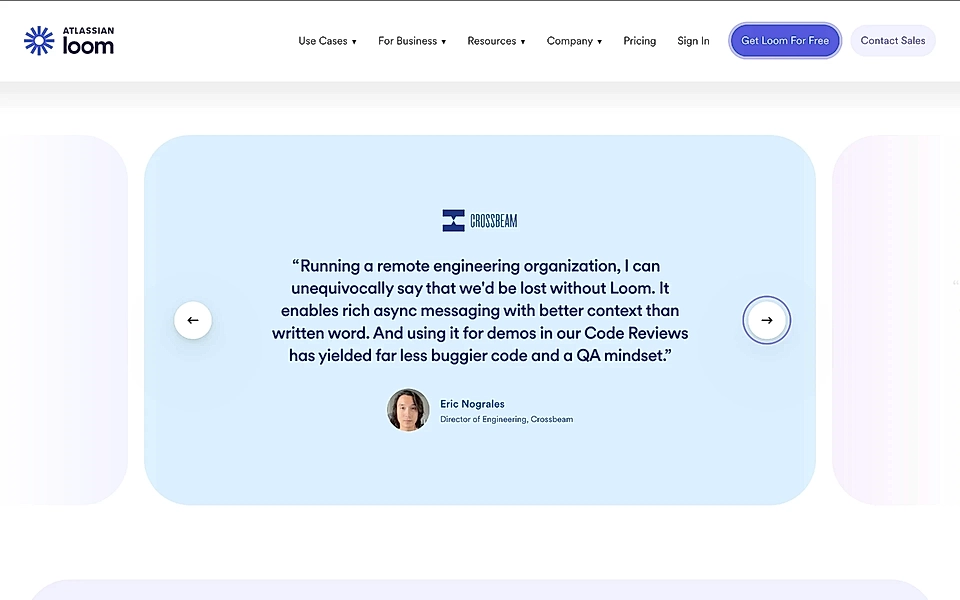
3. Keep testimonials short and use everyday language
Testimonials should be one or two sentences at maximum. From interviews and customer chats, pick short, simple sentences to keep them relatable.
4. Include the customer’s name and image
If possible, add the customer’s full name, their company, and an image – a LinkedIn profile image is a great option. Details add credibility and show website visitors that people like them are benefiting from your product.
5. Authenticity over studio quality for videos
If you’re using video testimonials, focus on authenticity rather than overly polished. Videos shot on a customer’s phone or laptop – or during a sales call, with real emotions and honest feedback usually resonate more than professionally produced content.
Blaze’s testimonials section is a fantastic example.

These five points should get you a long way and make sure you get the highest impact.
Now, let’s see how to collect testimonials.
How to gather testimonials for your SaaS
If you don’t have any testimonials gathered for your SaaS just yet, getting started might feel like a daunting task. You might be anxious and unsure if customers are willing to give you a testimonial in the first place.
It’s a task that SaaS founders and marketers keep pushing back.
But when you really think about it, testimonials can be found in surprising places and in tools that you might be using every day.
Here are seven practical ways to gather testimonials for your SaaS, even if you’re just starting out.
1. Contact customers directly via email or phone
A personal touch can go a long way. Reach out to your most loyal customers directly and ask them for feedback. Use your founder’s charm and explain how their testimonial could help others.
2. Automated outreach through emails and in-app messages
Use tools like Intercom and set up automated emails or in-app prompts that ask users for testimonials after key events, like successfully completing the onboarding. This method is easy to scale and keeps gathering testimonials consistent.
3. Ask for feedback at checkout
After a customer makes a purchase, ask what was happening in their life or business that made them realize they needed your tool. This approach can lead to great testimonials that highlight the problem your SaaS solves.
4. Crowdsource from social media channels
Go to places where your customers hang out and spark discussions that you can turn into testimonials. To make them a touch more credible, embed the original social media posts on your SaaS page (without edits).
5. Request reviews on third-party sites
6. Cut interviews or sales calls into clips
During customer interviews or sales calls, you can ask for permission to use their feedback as a testimonial. Use tools like OpusClip to create slick video clips that discuss real customer experiences.
7. Use customer chat messages
Customer support chats can be an unexpected goldmine for testimonials. When a customer shares how happy they are with your product, ask if you can use their words on your website. In the heat of the moment, they are more likely to say yes than later when they are working on something else.
As those seven ways show, gathering testimonials is less complicated and stressful than you might think. Some of them are just extensions of your routine tasks.
Now, let’s take a look at six real-life examples of how SaaS companies display testimonials on their websites.
6 SaaS websites show how to use testimonials in marketing
Lyne

Lyne, an email outreach platform for sales teams, shows one of my favourite testimonial examples using a clever trick of summarizing the key content of the customer quote. A quick summary makes it easier for page visitors to see if any of the quotes answer their frustrations and pain points.
Testimonials on Lyne’s page come with a customer image, name, job role, and company name to give credibility and match the landing page content – Lyne gets 5/5 from me.
Lemlist
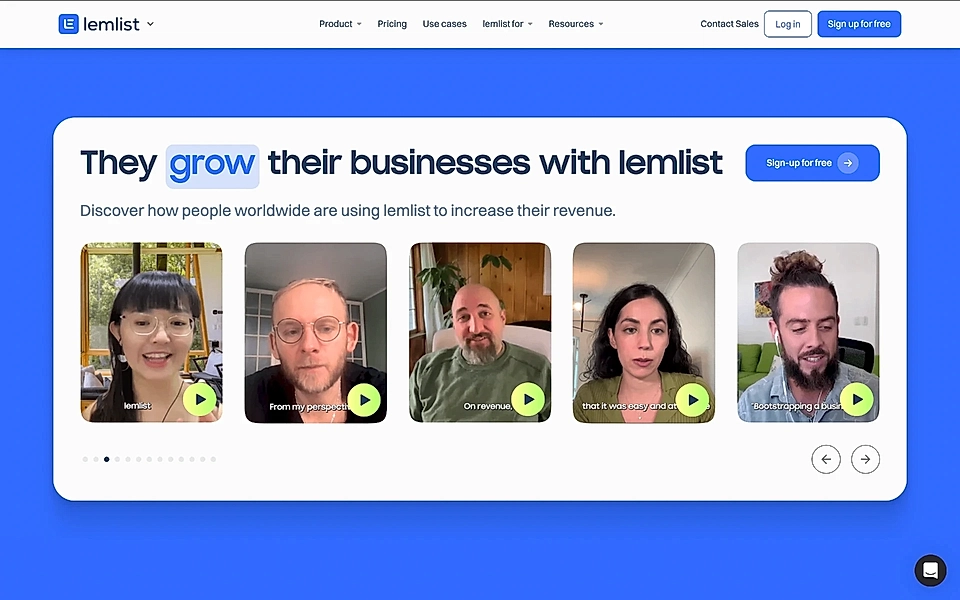
Not too long ago, I chose a service provider out of multiple options based on the video testimonials embedded on their website. When you are neck and neck with a competitor, social proof can give you that small advantage to close the deal.
And it’s not only consumer services and e-commerce sites – it's becoming more common for the best B2B SaaS websites to show Instagram Reels and TikTok-style videos from their customers. These raw, authentic videos shot on a laptop or phone can often have a bigger impact than polished, studio-quality marketing content.
Lemlist is one of the SaaS companies using this tactic. The title, ‘They grow their businesses with Lemlist’, is a great opener for the authentic videos that follow underneath. The sign up button on the top right of the element is strategically placed to capture the moment when the page visitor says “hell yeah, I think I’ve found the right solution” and is ready to take action.
If you're considering video testimonials, ensure the content (highlighting frustrations and outcomes from real customers) aligns with the messaging on your landing page.
Equals
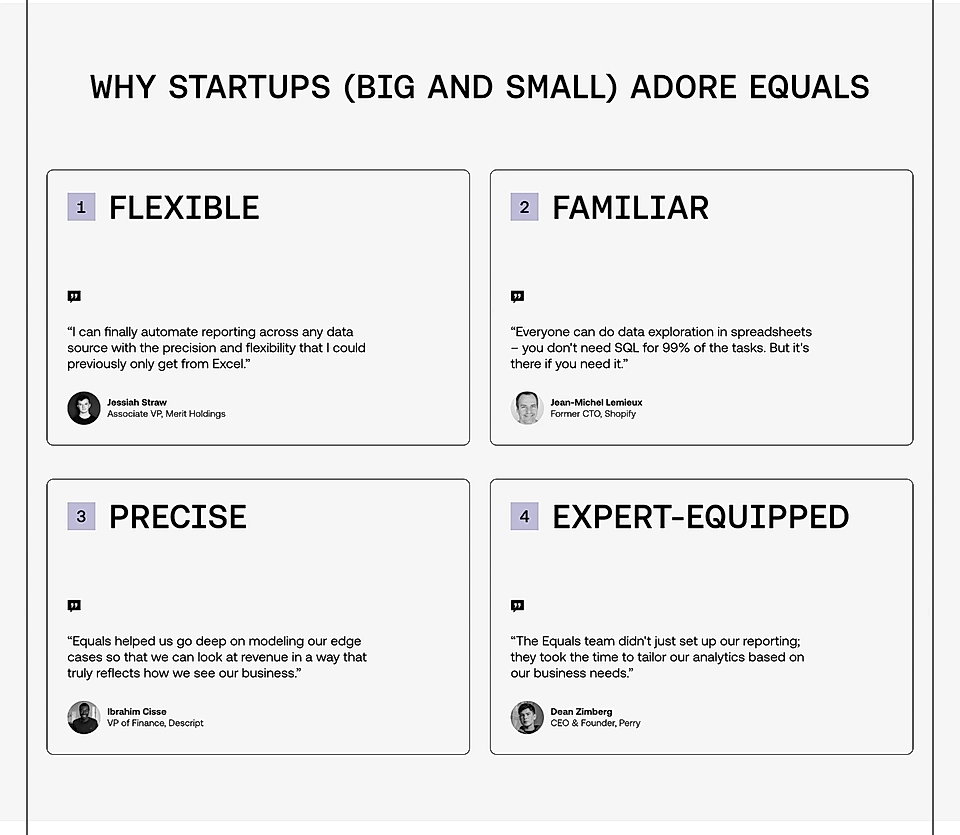
Social proof doesn’t need to be a separate element on the SaaS website.
Equals, a business reporting tool for startups, shows testimonials to give credibility to the benefits and key capabilities they claim the platform comes with.
The title, ‘Why startups (big and small) adore Equals’, sets the tone for this section, and the quotes from its customers convince page visitors that the startup’s marketing team does not just make up these benefits.
Creatie

One of the best ways to collect testimonials is to ask for feedback via channels where your customers hang out. It can be Reddit, YouTube, LinkedIn, X, or a much smaller community.
One of the clear benefits is that the testimonials via social channels are not only visible on your site but also get visibility far beyond your website audience.
Creatie is one of the many B2B SaaS companies that use social media aggregators to show a “Wall of Love” on their website.
With the right tools in place, collecting and displaying a feed like that takes a few minutes and keeping it up-to-date is effortless.
Xnapper
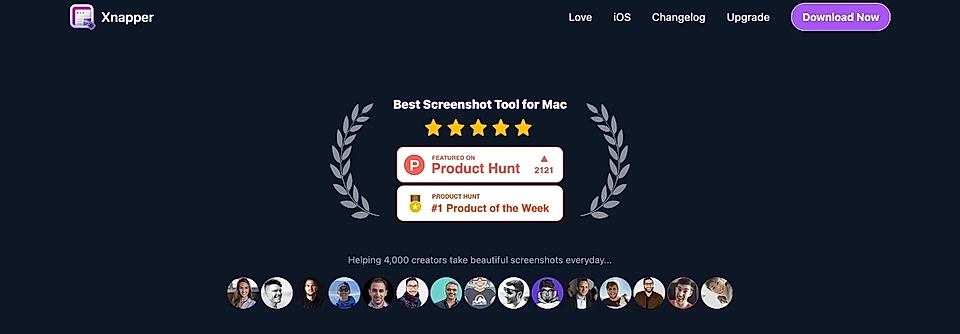
Testimonials don’t necessarily need to be visible on your website.
Sometimes, showing the star rating, customer avatars, and a link to a third-party service can be more efficient. It gives the page visitor an opportunity to browse through customer feedback and testimonials but keeps your site focused on the messaging you want to get through in a concise format.
That’s what Xnapper does with the ProductHunt badge in their hero section.
If your SaaS is looking to use tools like G2 and Capterra, collecting high-quality reviews can be tough. In the early stages, your marketing team may need to get creative, often manually gathering reviews and even drafting testimonials for customers to approve.
To scale your review efforts, use SaaS marketing tools like Intercom to automate requests at the right moments – such as right after a customer’s first purchase or when they leave positive feedback via live chat.
Slite
To wrap this up, let’s look at a SaaS landing page that goes all in with testimonials.
Slite, a knowledge base software somewhat similar to Notion, shows social proof eight times on its homepage. I’ve never seen anything like this.
It all starts at the hero section, where customer quotes are spicing up the hero section’s product image. Adding quotes on top of the image is a great way of capturing page visitor’s attention and making sure they’ll take a quick look at your product’s key visuals.
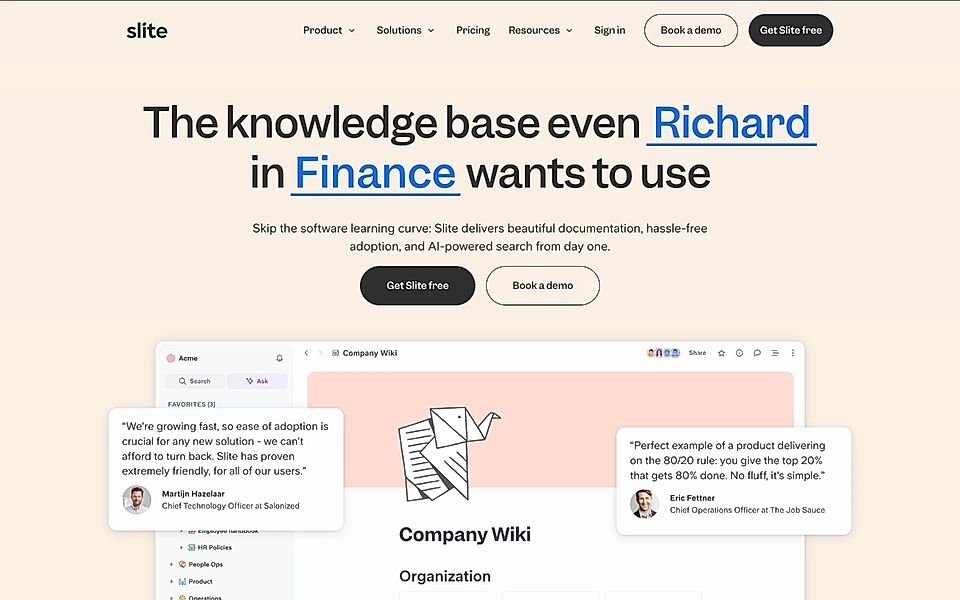
Immediately after the hero section, it’s time for the first benefit. Slite claims that their solution is easy to adopt and get started with ('in minutes, not weeks'). This claim might feel a bit generic – unless you take Slite’s approach and let your customer tell in their own words.
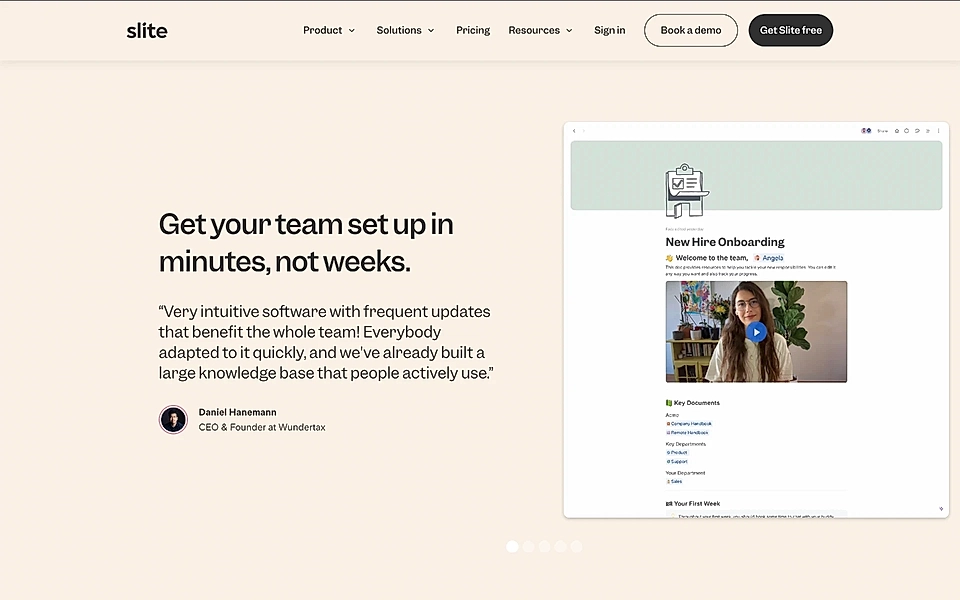
Alright, two out of eight are covered, and the next element introduces us to Slite’s search feature. Search is not the sexiest feature for any SaaS service, but hearing Slite’s customer describe it in their own words immediately makes it much more interesting.
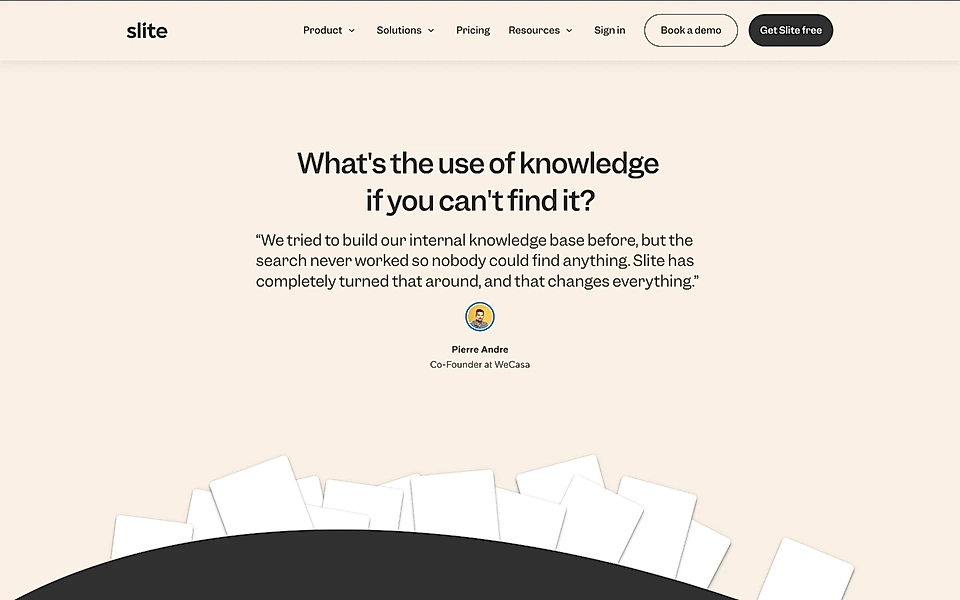
Next up is Claire from Displayce confirming Slite saves time and hassle.

I know what you are thinking – can there really be more social proof elements on a homepage?
You can’t make this up – it’s all real.
The fifth element introduces a key feature called the Knowledge Management Panel. It sounds abstract, but Slite’s customer says it’s a life-saver.
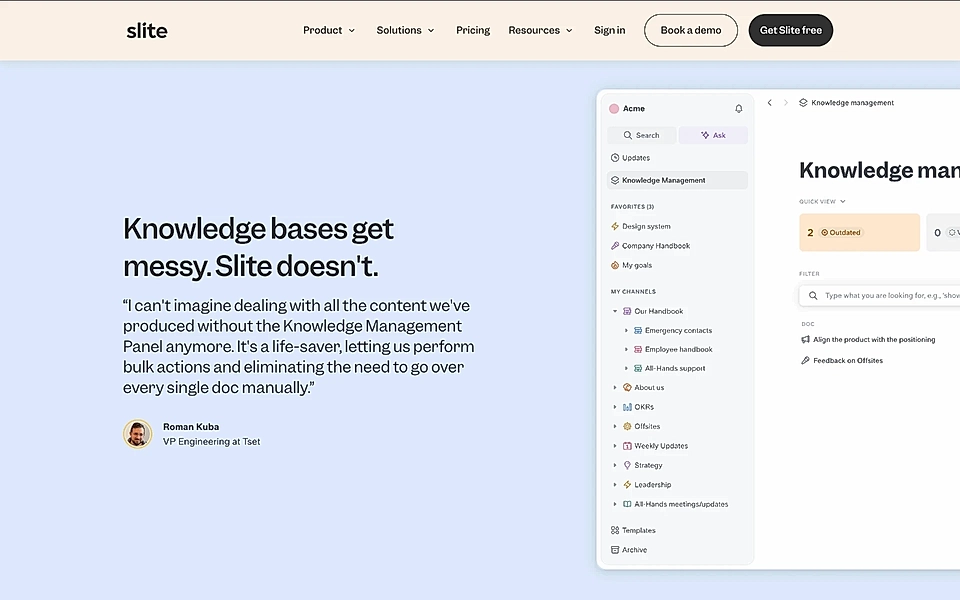
We’ve arrived at element six – a call-to-action section with bullet points on the left telling your team will get all the support they need if they sign up. On the right, a wall of love shows customer feedback.

After this element, there are actually two sections - a product image and a CTA without any social proof. Until now, the majority of the content has been talked about through customers’ voices.
The seventh social proof element directs users towards third-party review services to read more testimonials.
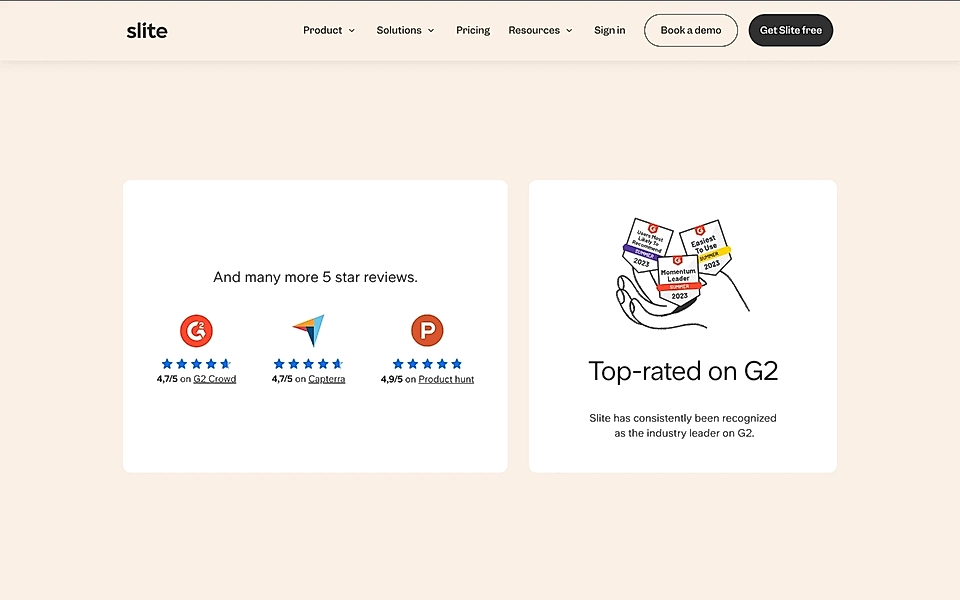
And finally, the footer makes sure there’s no page on the website without social proof.
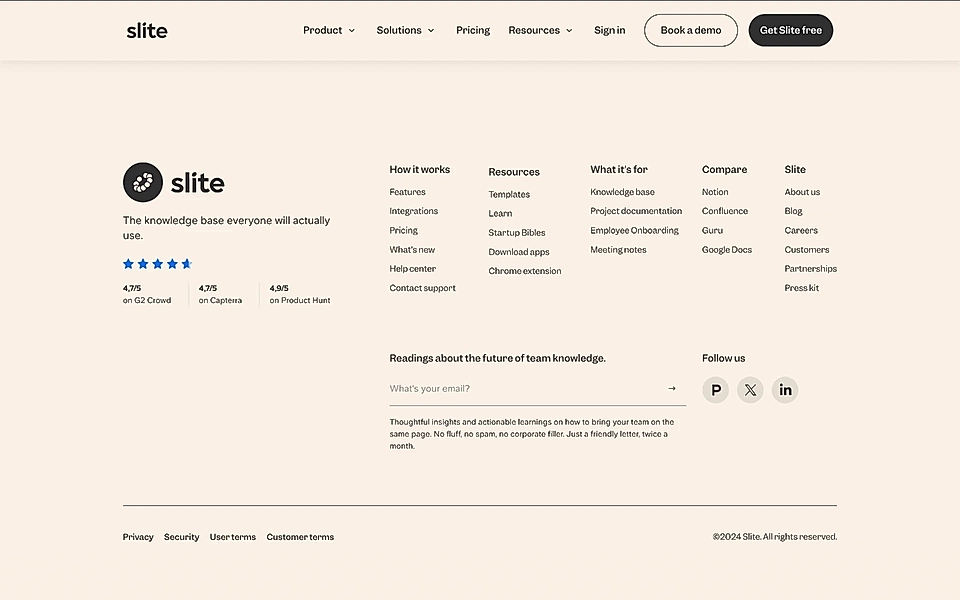
The company I founded previously helped brands collect social proof from various services, but I’ve never seen social proof used so thoroughly on a SaaS website. I’d love to be a fly on the wall and listen in to customer chats and hear their reactions.
Conclusion
These six examples show how testimonials can make a big difference on SaaS websites. Whether you're adding video testimonials, showing social media feeds, or sharing customer reviews, social proof helps build trust and get more people to take action.
If you don’t have testimonials yet, now’s the time to start collecting them. Use these examples to find simple ways to add real customer feedback to your site and turn sceptical visitors into paying customers.
Looking for even more ways to improve your SaaS landing pages? Check out our 100+ SaaS landing page examples packed with copywriting tips and strategies.